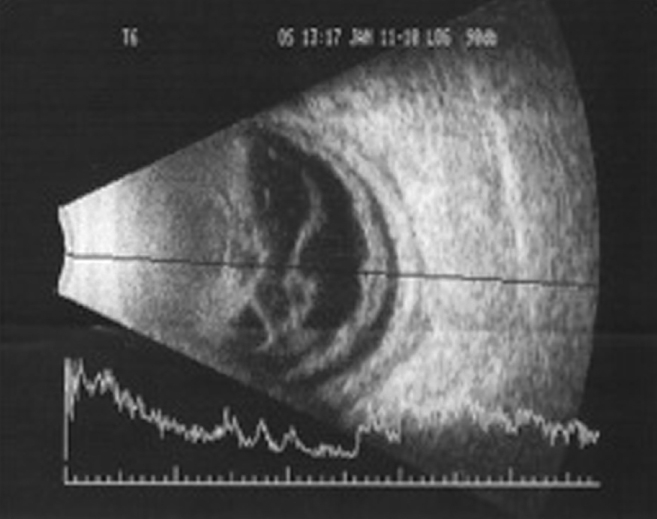To the Editor,
Complications may arise from use of haemodialysis catheters in the form of infections at the exit site, tunnel infections, bacteraemia and systemic infections. We present 2 cases of endogenous endophthalmitis secondary to sepsis in patients fitted with tunnelled catheters for haemodialysis.
Case study 1: Male patient 51 years of age with a history of type 2 diabetes mellitus and chronic kidney disease due to membranoproliferative glomerulonephritis associated with osteomyelitis. He was included in a haemodialysis programme in 2009, with a tunnelled catheter in the right brachiocephalic vein. The patient was hospitalised due to general decline, fever and dyspnoea. As a respiratory infection was suspected, systemic empirical antibiotic coverage was provided with ceftriaxone. The patient experienced pain in the right knee with signs of effusion and arthrocentesis was performed. The patient later presented with ptosis of the left eyelid, severe conjunctival chemosis, decrease in visual acuity upon light perception, preseptal cellulitis, almost complete ophthalmoplegia, ocular hypertension and anterior chamber fibrin. Ocular ultrasound revealed vitreous infiltration especially in the anterior area and retinal detachment (Figure 1).
The patient was diagnosed with panophthalmitis of the left eye, and blood and joint fluid cultures tested positive for Staphylococcus aureus resistant to methicillin. Given the poor anatomical and functional state, the treatment regime was vitrectomy and intravitreal injection of vancomycin and ceftazidime, with eye drops containing vancomycin, ceftazidime, cycloplegic agents, timolol and dexamethasone, and systemic antibiotic coverage with vancomycin and gentamicin in dialysate.
Vitreous humour cultures tested positive for Staphylococcus aureus, which confirmed the diagnosis. Treatment was maintained during 1 month and the ophthalmological outcome was poor, with formation of fibrin in front of the pupillary axis and phthisis bulbi.
Case study 2: 78 years old female patient undergoing haemodialysis since 2009 due to diabetic nephropathy with a tunnelled catheter in the right brachiocephalic vein. She was hospitalised due to recent fever, pain and erythema at the subcutaneous tunnel, with mild draining at the catheter exit site. Doctors decided to provide systemic empirical antibiotic coverage with vancomycin and gentamicin.
The patient experienced pain in the left eye 2 days later, accompanied by redness of the conjunctiva and loss of visual acuity. Ophthalmological examination revealed an intraocular lens, hypopyon, Tyndall phenomenon +++, normal intraocular pressure, vitreous infiltration, macular thickening, vitreous abscess and detached choroid in the left eye. She was diagnosed with endogenous endophthalmitis based on a positive blood test for methicillin-resistant Staphylococcus aureus.
Given the poor anatomical and functional state, doctors prescribed vitrectomy with intravitreal vancomycin and ceftazidime injections in association with moxifloxacin, dexamethasone and cycloplegic agent eye drops. Vitreous humour cultures tested positive for Staphylococcus aureus, which confirmed the diagnosis. Treatment was maintained during 1 month; total detachment of the retina with proliferative vitreoretinopathy occurred as a complication.
Endogenous bacterial endophthalmitis is a devastating complication of septicaemia, which constitutes 2% to 8% of all cases of endophthalimitis.1 It occurs when bacteria reach the eye through the bloodstream, by crossing the blood-retinal barrier. This is a severe disease which is often diagnosed late; its prognosis is very poor and many patients become blind.
Blood cultures may be positive in as much as 71% of patients with endogenous endophthalmitis, while vitreous humour and other aqueous cultures may test positive in 61% to 70% of cases.2 These cultures are crucial for providing a diagnosis, but all other possible infection sites must be cultured, including catheters and draining lesions. It is not uncommon for eye cultures to be negative. The most common gram-positive bacteria are Staphylococcus aureus, Group B Streptococcus, Streptococcus pneumoniae and Listeria monocytogenes. Among gram-negative bacteria, the most common are Klebsiella sp., Escherichia coli, Pseudomonas aeruginosa and Neisseria meningitides.
Treatments for endogenous endophthalmitis include systemic and intravitreous antibiotics. Treatment duration should be determined based on the need to treat the underlying cause of bacteraemia. Systemic antibiotics alone will not be sufficient, which is why intravitreous injection of antibiotics is also necessary. Vitrectomy with intravitreous injection of antibiotics is indicated in most cases. Vitrectomy provides better visual results in severe cases of endophthalmitis.3
Endophthalmitis is a rare complication of septicaemia related to haemodialysis catheters. We have only found 5 articles on this entity, reporting a total of 8 cases.4-7 In a case of suspected endophthalmitis, emergency ophthalmological assessment and antibiotic treatment are needed to reduce the risk of losing vision in the affected eye.
Conflicts of interest
The authors affirm that they have no conflicts of interest related to the content of this article.
Figure 1. Ocular ultrasound







